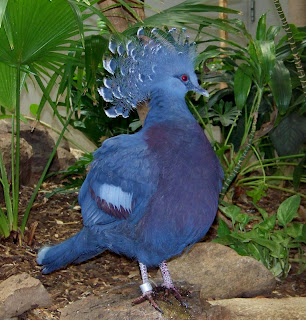This first group of birds exhibit extreme camouflage.
Would you spot these Tawny Frogmouths while walking in the woods? Probably not!
Is it an owl? No! This is not a bird of prey. Its name is Frogmouth. They are more closely related to nightjars. The three larger species are native to Australia and New Guinea, have large, flat, wide bills and enjoy prey such as frogs and mice. The twelve smaller species are found in tropical Asia, have smaller rounded bills and eat mostly insects. The species in the photo is a Tawny Frogmouth, found in Australia. Unlike birds of prey, these birds do not catch and kill their prey with their talons, they use their beaks. They are nocturnal predators, the explanation for their large owl-like eyes. They are ambush predators, similar to some species of owls. They sit camouflaged in a tree and wait for food to come to them!
This is the African Jacana.
Jacanas are found worldwide in tropical areas.
The feet of Jacanas are really bizarre. The have extremely long toes and claws in order to walk on lily pads! The claws and toes work like snowshoes and help to distribute its weight and keep it from sinking. It’s a pretty amazing adaptation! These birds find insects on the water and on the vegetation in the water.
The Southern Cassowary is the third tallest, (5-6 feet) and second heaviest living bird (75-125 pounds) in the world.
The Cassowary can be considered one of the most dangerous birds. Native to the tropical forests of New Guinea and nearby islands, these birds have several unusual physical characteristics. The most common of the three extant, or living species is the Southern Cassowary. As adults they have blue skin on their necks and part of their head, neon pink to red wattles, and horn-like but spongy crests on their heads called casques.
Close up of Southern cassowary
Cassowaries are very shy, but if disturbed, they can inflict serious injury on people and other animals. On the inner of its three-toed feet grows a five-inch dagger-like claw that has the ability to disembowel people! They deliver fast, powerful kicks to their enemys and can jump up to 7 feet high. They mostly eat fruit. These birds are quite territorial and have given zookeepers serious injuries. Also interesting is that the females do absolutely nothing to help raise her chicks. All she does is lay eggs and then she moves on. The male is left to incubate the eggs for up to two months. Once they hatch, he protects them for up to sixteen months, and then chases them off to live on their own.
The Southern Cassowary’s inner claw can grow up to 5 inches.
I saw a Victoria Crowned Pigeon for the first time when I visited the Saint Louis Zoo. They are the largest pigeon species in the world and have a variety of blue and purple feathers, red eyes, and have a beautiful feather crest on their heads. They are native to lowland and swamp forests of New Guinea and surrounding islands.
There are 2 other species of crowned pigeons that look similar to this Victoria Crowned Pigeon.
As you can see, the diversity of birds is so vast! Part of the World Bird Sanctuary’s mission is to maintain biological diversity on our earth so future generations can enjoy the same amazing animals. Stay tuned next month for part 3 of Really Weird Birds!
Submitted by Sara Oliver, World Bird Sanctuary Naturalist







No comments:
Post a Comment